Powerdynamo brings new ignition & light
to your vintage motorcycle
|
Powerdynamo brings new ignition & light |
|||||
| general assembly instructions system 70 02 799 48 and 70 02 799 52 |
Version 07.11.2017 |
|
If you can install and time a stock ignition and
possess basic mechanical skills, you can install a Powerdynamo! |
|
| Powerdynamo can not monitor the compliance to those instructions, nor the conditions and methods of installation, operation, usage and maintenance of the system. Improper installation may result in damage to property and possibly even bodily injury. Therefore we assume no responsibility for loss, damage or cost which result from, or are in any way related to, incorrect installation, improper operation, or incorrect use and maintenance. We reserve the right to make changes to the product, technical data or assembly and operating instructions without prior notice. | |
|
|
Please read these
instructions fully and carefully before starting work on your motorcycle Please bear in mind that any modification of the material as well as own repair attempts which have not been agreed with Powerdynamo may result in a loss of warranty. Do not cut off wires. This leads to a loss of reverse polarity protection and often results in damage to electronics. Also, please take note of the information provided on the information page for this system. Check that what you have bought really corresponds to the motorcycle you have. Wrong ignition settings may damage your engine and even hurt you during kickstart (violent kickbacks). Be careful during the first test runs. If needed change settings to safer values (less advance). During assembly check carefully that the rotor (flywheel) does not touch the stator coils or anything else, which may happen due to various circumstances and lead to severe damage. |
| Designated use This system is designated to replace stock dynamo/alternator & ignition systems in vintage and classic motorcycles whose engine characteristics have not been modified aftermarket. This system is not a tuning system and it will not bring significant increases in engine output. It does however significantly enhance roadworthiness and comfort by offering better lighting, better function of side indicators and horn and, compared with the aging stock systems, increased reliability. As our system does not tamper with engine characteristics it does not increase emission of gaseous pollutants and noise. In most cases emission of pollutants should even be reduced due to better combustion. If used as designated the system therefore will not normally infringe the existing legal status of the motorcycle (this statement is valid for Germany, for other countries, please check locally against your road licensing regulations). This system is not suitable for use in competition events. If used other than the designated way, warranty will be voided and it might well be that you do not obtain the desired results or, worst you loose legal roadworthiness. The charging system is only suitable for use with rechargable 12V (6V systems 6V) lead-acid batteries with liquide electrolyte or sealed lead-acid batteries, AGM, Gel. It is not suitable for use with nickel-cadmium, nickel-metal-hydride, lithium-ion or any other types of recharchable or non rechargable batteries. This is a replacement system and not a copy of the stock material. The parts in this system therefore look different and might fit differently (notably ignition coil and regulator) requiring some adaptation by you. |
|
| During assembly imperatively start with assy of engine based parts to see that those really fit before you start fitting the external parts. In many cases customers assemble those first and thereby often modify them in breach of warranty which renders them unfit for renewed sale. Replacing old ignition systems is not a matter of taking something from a supermarket shelf as there have been very many types, versions and possibly unknown aftermarket modifications which harbour plenty of room for error. | |
| Our systems are NOT tested for use with third party electronic devices (such as GPS, mobile phones, LED lighting etc)and may cause damage to such parts. Possibly existing electronic tachometers will not work with the new system. Read our information for suitable solutions. Possibly existing safety switches and electronic valve controls are not supported. It might be that your motorcycle was originally equipped with an ignition that did limit top speed for legal reasons. The new system does not have such a facility, so check your legal situation beforehand. | |
| If you have no expertise for the installation have it done by an expert or at a specialist's workshop. Improper installation may damage the new system and your motorcycle, possibly even lead to bodily harm. | |
| Before you order a system, please check whether a puller
tool for the new rotor is included in the kit. If not,
better order it at the same time. You might want to order light bulbs,
fuse, horn,
flasher
unit etc. Never use anything other than the recommended puller tool to pull the new rotor again. Damage to the rotor as a result of use of other tools or methods is not covered by warranty. |
|
| The rotor is sensible to blows (including during transport). Before assembly, please always check for damage (on rotor without magnet plastification try to push the magnets aside with your fingers). After impact the glued in magnets might have broken loose, sticking to the rotor solely by magnetic force, so that one does not notice right away. During engine run the damage would be considerable. Before placing the rotor onto the engine, please make sure that its magnets have not collected any metal objects such as small screws, nuts and washers. That equally would lead to severe damage. | |
| If you have access to the Internet, best view those instructions online. You get larger and better pictures by clicking onto them and possibly updated information. System list at http://www.powerdynamo.biz | |
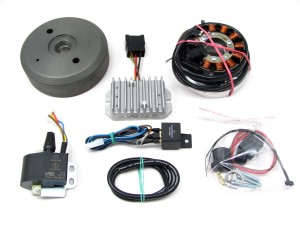
|
You should have received those
parts:
|
|
|
|
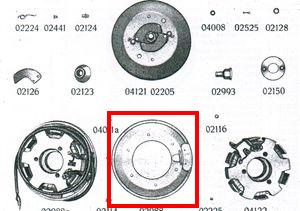
|
Take the old stator from the rear cover plate (6 screws from the rear side). This plate (in picture from catalogue here marked in red square) is the only part, that will be needed further on.
|
|
|
|
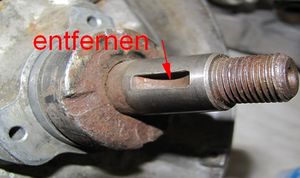
|
Remove the woodruff key from the crank. No worry, this woodruff had no holding function, but a guiding function. (See info here) Should you forget this step, you will have to remove the complete
assembly again to get access to the woodruff. |
|
|
|
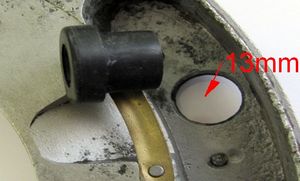
|
Now comes the only point where you have to physically modify the stock material. Enlarge the wire exit in the back plate to13mm to accommodate the rubber grommet for the new cable. |
|
|
|
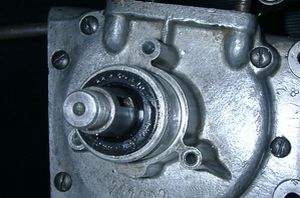 |
This is how your engine block now looks like. Use this free situation to check and clean it. |
|
|
|
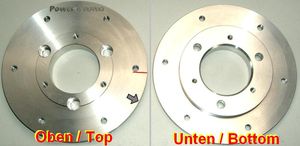 |
Take now the new lower (larger) adapter plate. The plate has many holes (the top-side, the one facing you during installation, has 3 sunken holes for the fastening screws M7 and writing Powerdynamo). |
|
|
|
|
Place the lower adapter plate on the old DKW cover plate and screw it down with the 6
new hex-countersunk screws M6, just as the stock stator had been. As it is possible to shift the adapter position in 60° steps, make sure you use the position shown here, with the arrow pointing towards the wire exit. Otherwise the wire will not exit this direction later on. |
|
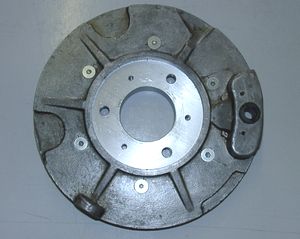 |
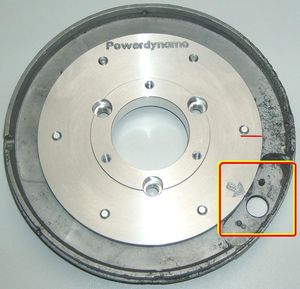
|
|
|
|
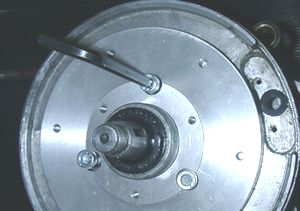 |
Put this pre-assembled plate onto the engine and screw it down with the 3 new hex screws M7. Make sure the screws really tighten the plate (dirt in screw holes may create a problem) |
|
|
|
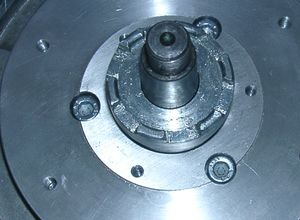 |
Reset the bearing nut on the crank stud and screw it down carefully. The following steps can be done with the nut fitted. |
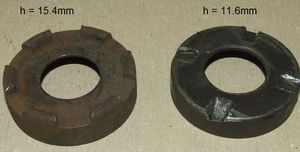 |
NOTE: there have been (or are now due to aftermarket production)
differently high nuts! Also, it may be that after installation of a new bushing there the nut is too high. We have seen nuts 11.6 and 15.4mm total height. The nut 15.4mm is for this assembly too high and can NOT be used |
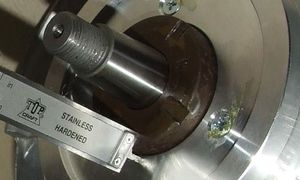 |
After install of the middle adapter you will get from top of
highest position of the nut to the level of the inner circle of the
middle adapter (see photo) # about 10mm with nut 11.6mm |
|
|
|
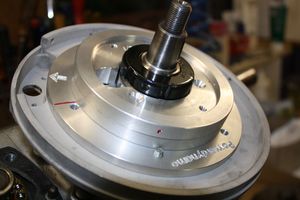 |
Take now the middle adapter plate (see left) and put it on the lower adapter plate. The plate gets fastened by 3 countersunk
holes M5. To get correct wire position later on, mount it in a way
the cut out (nose) shows into some 4 o´clock position as shown
here. |
|
|
|
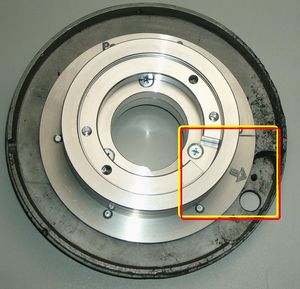 |
Now the upper adapter plate (with the sideways cable opening on the unit): Put it on in that way, that this opening shows direction wire exit and that one set of the hole-pairs matches the screw holes in the adapter below. |
|
|
|
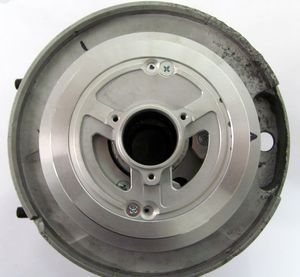 |
Place the stator holder plate - without the stator coil - on top.
|
|
|
|
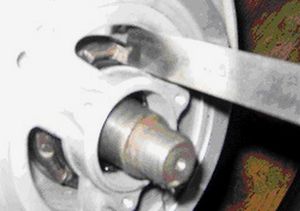 |
very important: Imperatively check whether there is some room between the highest level of the nut and the bottom of the stator coil carrier plate. Should the nut press against the plate you will have problems - plate breaks leading to severe destruction of coil and magnets. But, please check how much space you have - not only that you have. This value may be needed so solve a potential fitment problem of the rotor (see below). |
|
|
|
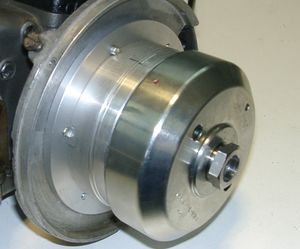 |
Without the stator coil fitted, place the rotor on and tighten the rotor fastening nut to make sure it really sits as it should. Doing so, check that the rotor does not hit something at the construction below the rotor. This unfortunately is important as the setup is rather tight and material of the time did vary a little, not to mention aftermarket changes and repairs. Than loosen the nut again. Should you now be able to pull the rotor without use of the puller (M27x1.25) than you can be sure that the rotor had hit against something and did not sit on taper. |
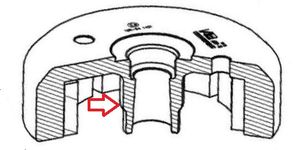 |
Should there be some conflict between rotor and adapter setup than
in most cases this is because the step on the rotor shaft will
conflict with the stator carrier plate. Under no circumstances try to solve this by machining this step. It is there by design to prevent damage of the stator coil due to low rotor seat. The solution would be to modify the middle adapter plate (making it lower). Here you need to know by how much this can be done - hence the check of what free room there is (see above). Has there not been any free room (and already the flatter nut) and is the rotor still hitting base you can not install the system. Please contact us in such a case. |
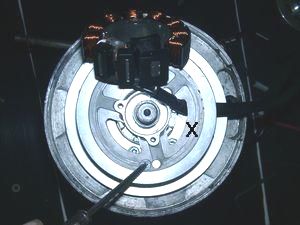 |
Now place the new stator coil back to the holder plate. At time of delivery the stator coil is pre-assembled on the ground plate. You have to remove the 3 screws M4. Then lift-off carefully the coil a little (don't damage the paint insulating!) until you have access to the 3 mounting holes of the ground plate. Lead the cable through the sideways opening of the upper adapter.
There are 2 cable openings in the plate. It's important for the
ignition adjusting, to use the with an "X" marked. (The
unit is pre-assembled in that way!)
|
|
|
|
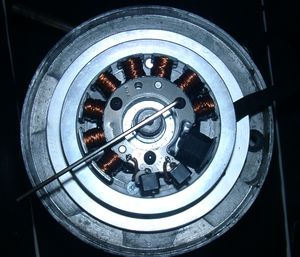 |
|
|
|
|
| Lead the cable through the enlarged cable exit hole (with the grommet) to the rear side. | |
|
|
|

|
Remove the spark plug to ease turning of the crank. Bring the piston into
ignition position. |
|
|
|
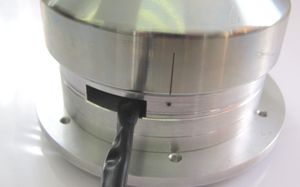 |
Have a look at the new rotor. You will find on its circumference a lasered on line (older rotor small red drilled marking). Also, you find on the upper adapter a small marking. These are ignition markings. Now set the rotor onto the crank in such a way, that the marking on the rotor is align with the marking on the adapter. If there is any change in the crank's (ignition) position, you have to start again. In that position fasten the rotor carefully with the enclosed tubular nut M16. |
|
|
|
| Work on engine is now finished. Place spark plug back. Put the plug housing over the new stator wires leading to the new ignition coil. Make sure not to mismatch wires there. red connects to red, white to yellow and brown to brown mistaking this may result in coil destruction. |
|
|
|
|
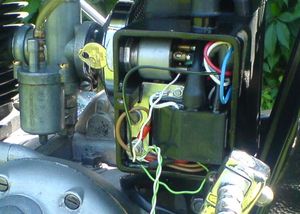
|
Remains to fasten the new ignition coil and the regulator as well as the rely at some convenient place on the motorcycle. It is possible to fit the ignition coil inside the DKW switch box (with some effort)
|
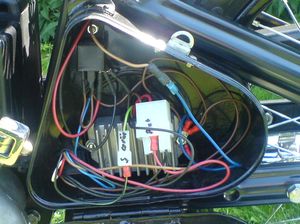
|
The regulator and the relay may be housed in the tools compartment.-
|
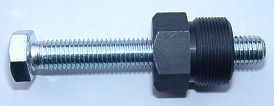 |
To pull the new rotor again, you will need the enclosed puller tool
M27x1,25 (part 99 99 799 00).
|
|
|
|
|
Connect the parts as shown in the respective wiring
diagram! |
||||
|
* |
To facilitate wire exit through the often small openings in the engine casing, the plastic plug of the generator's wiring that leads to the ignition coil have not been put onto the wire terminal. You should place the plug there only once all has been properly installed on the engine side. | |||
|
|
Look for the ignition coil with its female plug and the three wires (red,
brown and yellow).
Put the provided 4-position plug housing onto this plug and insert the three wires (red, brown and white) from the generator. Make sure that the terminals engage securely in the housing and that you connect:
|
|||
|
Should you need (or want) to get the terminals out of the plug housing again, enter a paper clip from front next to the terminals and push the little barb aside. Than pull the wire out. |
||||
| * | Connecting Powerdynamo alternator to lighting circuit (via regulator): | |||
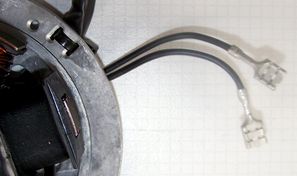
|
The 2 black wires running from the stator
coil carry the voltage for lights, horn, flashers etc. They have nothing
to do with ignition. This voltage (something between 10 and 50 volts AC) has however to be stabilized (regulated) and for most uses rectified into direct current (DC) as it primarily is alternating current (AC). For this we offer 2 different regulators: |
|||
|
|
||||
|
* |
Regulator type 1: with standard DC regulator (95 22 699 06), use the wiring diagram 73ir12: | |||
|
* |
|
The new regulator/rectifier has a compact plug with 6 positions, of which one is not used. A female plug cover fitting to this plug is delivered. Into this female plug you have to insert the following wires (which have terminals that snap into the plug): | ||
| The two black cables leading from the generator ... |
... connect to pins 1/4 of the new regulator (from there equally black wires lead inside the unit). It does not matter which wire connects to which of the both terminals (1/4) as they carry alternating current. |
|||
| The new brown cable with the round eye terminal ... |
... connects pin 3 of the regulator unit (from there equally a brown wire goes inside the unit) with the negative pole of the battery or (in case you drive without battery) to ground (chassis). |
|||
|
The new red cable with the round eye terminal ... Take care: |
... connects to pin 5 of the new regulator (from there equally a red wire goes inside the unit). Here your regulated positive voltage comes out to connect to battery plus, or (in case you drive without battery) to the voltage input terminal of the main switch (ignition lock, German bikes: pin 51/30). |
|||
| Make sure that you have a 15A-fuse between battery and vehicle circuitry. | ||||
|
The green/red wire at pin 6 of the new regulator ... Remark: |
... is for the charge control light.
You connect there the wire that formerly did run from the control light to
the original regulator. |
|||
| The charge light control function is based on a transistor switch and is an additional function. Even if that should fail, the regulator might still be in ok working condition. Simple check: have the engine running, turn lights on, disconnect the battery. If you have bright lights the unit is ok. | ||||
| * | Regulator type 2: with DC regulator with built in smooting condenser (73 00 799 50), use additional the wiring diagram reg_102: | |||
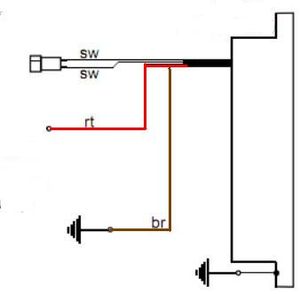
|
|
|||
| * |
Remains the blue (sometimes blue/white) wire at the ignition coil. This is the kill (cut-off) wire. Connected to ground - it will stop ignition!
Note: |
Switch off via separate kill switch (when driving without battery): The relay will not be fitted. The blue(/white) cable of the ignition coil will be connected to a kill switch, closing against ground (a button at the handlebars). Or you mount an ignition lock that has a facility to connect against ground when in OFF position. Battery method: |
||
|
The brown wire with the ring terminal
from pins 87a und 86 goes to ground.
The black wire from pin 85 goes to a main switch terminal carrying voltage if switched on. |
|||
| * |
Screw the high tension (ignition) cable ...
Please do not use any spark amplifying cables, such as "Nology supercables" or "hot wire". This will disturb the system and possibly damage it. |
... into the ignition coil and pull over the rubber seal before
mounting the
coil (it will be easier).
Please do use the cable arriving with the pack and not any old cable. |
||
|
You will do yourself a favour to treat your bike to new spark plugs and
spark plug sockets (preferably some between 0-2kOhm).
Plenty of problems are to be traced back to "apparently good" (even
completely "brand-new") sparks plugs, terminals and cables. Do not use spark plugs with an intern suppression resistor. NGK (e.g.) offered such spark plugs coded with an "R" (for resistor). |
||||
|
* |
Finally - and before installing the battery and before the first kickstart - please re-check carefully all connections and fitments against the wiring diagram. Do check battery and light bulbs for correct voltage (12V). Should something not work, please consult our trouble-shooting guide on our homepage. As a first step disconnect the blue wire from the coil and re-test. |
|||
| * |
IMPORTANT: During crank shaft repair the dynamo shaft is often
machined and gets shorter. The result is a rotor sitting lower, possibly
touching now with its rivets the stator coil. The result is a destroyed
stator and ignition failure. For more detail and how to check see (online) here. |
|||
|
|
Important safety and operating information |
|
# |
Safety first! Please observe the general
health and safety regulations motor vehicle repair (MVR)
as well as the safety information and obligations indicated by the
manufacturer of your motorcycle. The timing marks on the material are for general guidance only during first installation. Please check after assembly by suitable means (stroboscope) that settings are correct to prevent damage to the engine or possibly even your health. You alone are responsible for the installation and the correctness of settings. |
|
# |
Ignition systems generate high tension! With our
material right up to 40,000 Volts! This may, if handled carelessly, not
only be painful, but outrightly dangerous.
Please do keep a safe distance to the electrode of your spark plug and
open high tension cables. Should you need to test spark firing, hold the
spark plug socket securely with some well insulating material and push
it firmly to solid ground of the engine block. Never pull sparkplug caps when engine is running. Wash your vehicle only with engine at standstill and ignition off. |
|
# |
Should you have received in the kit HT cables with a fixed rubber boot(which does not contain a resistor) you might have to use spark plugs with an inbuilt resistor (or replace the cap with one containing a resistor) to comply with your local laws. |
|
# |
After installation, please check tightness of all screws, even those preinstalled. If parts get loose during run, there will be inevitably damage to the material. We pre-assemble screws only loosely. |
|
# |
Give the newly installed system a chance to work, before you start
to check and test values, or what is worse apply changes to it. Our parts have been checked before delivery to you. You will not be able to check much anyway. At any rate do refrain from measuring the electronic components (such as ignition coil, regulator and advance unit). You risk severe damage to the inner electronics there. You will not get any tangible results from the operation anyway. Bear in mind that also your carburetor, your spark plugs and spark plug sockets (even if completely new) might be the reason for malfunction. The general experience with our systems is that the carburetor will have to be re-adjusted to lower settings. Should the system not start after assembly, first disconnect the blue (or blue/white) cut-off wire directly at the ignition coil (or in some cases advance unit) to eliminate any malfunction in the cut-off circuitry. Check ground connections carefully, make sure there is a good electrical connection between frame and engine block. In case of troubles, please consult our Knowledge Base first before you send off the material to us for checking |
|
# |
The spark of classic, points based ignition systems has with about 10,000 Volts comparatively little energy and looks therefore yellow and fat (which however makes it highly visible). The spark from our system is a high energy spark with up to 40,000 Volts and therefore is needle thin focused in form, and blue in colour, which makes it not so visible. Furthermore you get spark only at kick-start operated speeds and not by pushing the kick-lever down slowly with your hand (as you might get with battery based ignitions). |
|
# |
Systems using a twin outlet ignition coils have a few peculiarities. Please observe that during tests on one side, the other has either to be connected to an fitted spark plug or securely earthed/grounded. Otherwise there will be no spark on either side. Also with such open exits long and dangerous sparks may fly all over the coil. |
|
# |
Never do electric arc welding on the bike without completely disconnecting all parts containing semiconductors (ignition coil, regulator, advance) stator and rotor need not be taken off. The same is true for soldering. Before touching electronics disconnect the soldering iron from mains! Never use copper putty on spark plugs. |
|
# |
Electronics are very sensitive to wrong polarity. After work on the system, do check correct polarity of the battery and the regulator. Wrong polarity creates short circuits and will destroy the regulator, the ignition coil and the advance unit. As a rule, wiring will always be colour to colour. Instances, where colour jumps between wires are expressly mentioned in our instructions. |
|
# |
When you handle the new rotor, take care not to damage its magnets. Refrain from direct blows to the circumference of the rotor. When transporting never put the rotor over the stator. Observe our information relative to transport of the material. |
|
# |
Do not use spark plug sockets with a resistance of more than 5kOhm. Better use 1 or 2kOhm ones. Bear in mind that spark plug sockets do age and thereby increase their internal resistance. Should an engine start up only when cold, a defective spark plug socket and/or spark plug is very probably the cause. In case of problems check high tension cables too. Never use carbon fibre HT-cables, never use so called "hot wires" which promise to increase spark. |
|
# |
It is a good idea to cover the rotor in a thin layer of oil to reduce the risk of corrosion. |
|
# |
Never use a claw puller or a hammer to disengage the rotor. Its magnets might become loose in the event. We offer a special puller for disengaging the new rotor again (see assembly instruction)! |
|
# |
Should the motorcycle not be in use for some longer period, please disconnect the battery (so existing) to prevent current bleeding through the diodes of the regulator. Though, even a disconnected battery will empty itself after a while. |
|
# |
Please do observe these remarks, but at the same
time, don't be afraid of the installation process. Remember, that before you, thousands of
other customers have successfully installed the system. Enjoy driving your bike with its new electric heart! |